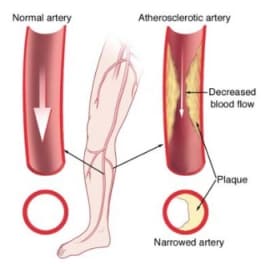Peripheral Artery Disease
by
Regine Epps
Cardiovascular Disease/Disorder
Description
The peripheral arterial disease (P.A.D) is characterized by having narrow blood vessels outside of your heart and atherosclerosis. Due to atherosclerosis, the sufferer of PAD has an accumulation of fat, cholesterol, calcium, fibrous tissue, and separate substances in the blood. The accumulated substances make up the plaque in the walls of the arteries that provide blood to the arms and legs. Insufficient blood flow to the legs will cause the tissues in the legs to die. An inadequate amount of blood flow will also affect the blood flow to the heart, arms, kidneys, and stomach. In some severe instances the sufferer will need their leg or foot amputated. At that stage, the person most likely suffered from gangrene and now suffers from critical limb ischemia (CLI).
Medical Treatments
There are many ways in which to treat P.A.D. that will help offset the effects of the disease. The individual can help contribute to improvements by targeting their lifestyle habits and change them. They can start becoming more active by inserting exercise in their daily routines, working on their smoking habits and eventually get rid of them, and heart-healthy foods such as eggs, lean meats, vegetables and fruits, fish, and low-fat dairy, etc. In more extreme situations, the medical professionals will encourage surgery or procedures. Bypass grafting is recommended when the blood flow in the afflicted area is blocked or almost blocked. To accomplish this surgery the doctor will take a vessel from a separate section of the body and it increase the blood flow it doesn’t cure P.A.D. The doctor may perform the procedure called, angioplasty to open blood flow to the narrow or blocked artery. With this procedure, a catheter with a balloon is intravenously inserted into blocked artery. The catheter will restore the blood flow by expanding the artery and pushes plaque against the artery wall. Also, in this procedure a medicated stent used to prevent future artery blocks. Lastly, atherectomy is the procedure that uses a catheter that’s inserted into the strained artery to cut or shave off plaque. And the tiny particles of plaque are washed away in the blood. An atherectomy can be performed with a laser used to dissolve the blockage.
Data
It’s important to understand the risk factors associated with any disorder or disease. The risk factors associated with P.A.D. are smoking, high blood pressure, diabetes, high cholesterol. The disease affects both men and women. But, it is said that African Americans have an increased chance, Hispanics have a higher chance than those that are non-Hispanic. According to the CDC, about 8.5 million people between the ages 40 and up have been diagnosed with PAD. Individuals with the preexisting conditions PAD can developing diseases such as coronary artery disease and cerebrovascular disease. The chief symptom associated with PAD is leg pain when exercising but 4 in 10 people experience no leg pain at all.

References
https://www.nhlbi.nih.gov/health-topics/peripheral-artery-disease
https://medlineplus.gov/peripheralarterialdisease.html
data
https://www.cdc.gov/heartdisease/PAD.htm
Comments (0)
You don't have permission to comment on this page.